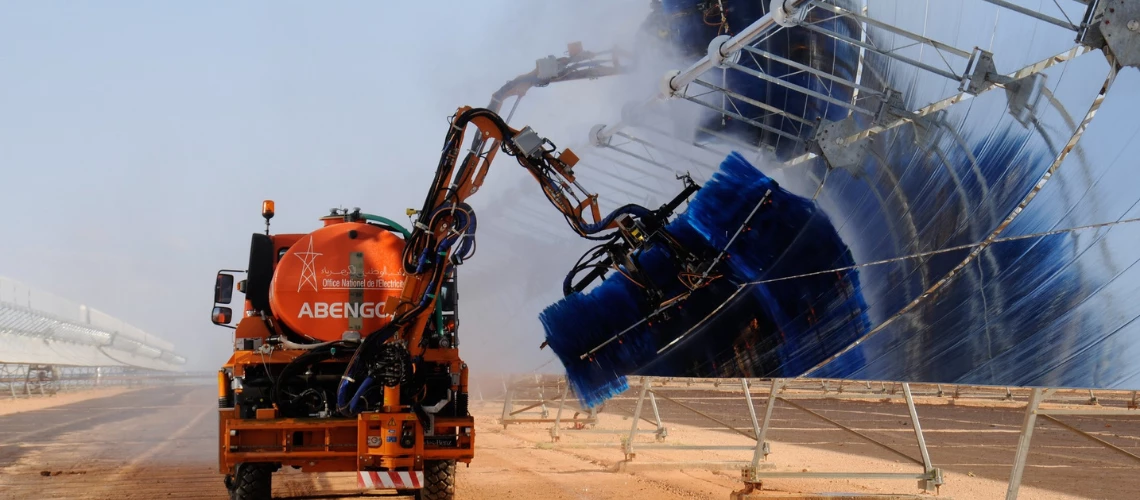 Truck sprays blue liquid on solar panels
Truck sprays blue liquid on solar panels
This reading list is based on the April 2021 edition of the Knowledge4Jobs newsletter, curated by the World Bank’s Jobs Group and Labor & Skills Global Solutions Group. Click here to sign up for the Knowledge4Jobs newsletter.
This month’s reading list highlights jobs issues in the context of the COVID-19 pandemic and the longer-term shifts needed to address climate change challenges.
The creation of green, sustainable, and better jobs is pivotal in responding to the dual crises of the COVID-19 pandemic and climate change. On the one hand, the pandemic has had a severe impact on employment – with the equivalent of 225 million jobs lost to the pandemic in 2020 alone - which will need to be remedied in support of a full economic recovery.
On the other hand, jobs will be affected by climate change, as well as by policies aimed at mitigating and adapting to its impacts. Labor productivity and human capital already face challenges related to climate impacts – a trend that is set to continue and worsen. The estimated 1.2 billion jobs in natural systems, agriculture, and the environment are particularly vulnerable. These impacts will need to be managed to deliver resilient employment going forward.
In the short term, well-designed climate action can be used to ameliorate the employment impacts of the pandemic, while also supporting mitigation and adaptation efforts. Climate-related investments and policies — from building retrofits to expanding public transit systems — can contribute to immediate job creation and generate new economic activities. Interventions in nature-based solutions, such as landscape, watershed, or forestry management, are often labor intensive, as is the maintenance of infrastructure assets. Climate policies can also support employment gains indirectly, for example, through a shift from labor taxation to environmental taxation or by expanding access to affordable and clean electricity.
Over a longer time horizon (2030/2050), multiple studies suggest that climate policies (and related measures, such as circular economy interventions) are likely to have a positive but limited impact on global labor demand. While these policies alone are unlikely to solve the structural employment challenges facing developing countries, they also will not compound them. The employment risks of the net-zero transition are modest in comparison to previous episodes of job reallocation or the possible impact of other contemporary trends, such as digitization and Artificial Intelligence (AI).
Nevertheless, the impacts of climate change and climate policies will be felt more acutely by some groups or regions over time, such agriculture jobs. Special efforts will be needed and can help manage these impacts and support job creation (e.g. Poland).
In addition, many displaced workers will require some degree of upskilling, reskilling, and further education. New skills will also be needed to ensure the adoption of energy efficiency practices in construction, deploy telecommuting, or switch to more resilient and sustainable agricultural practices.
Active and inclusive labor policies and community investments can help support workers and minimize the social costs of a green transition , as is shown by research on previous transitions such as those resulting from trade liberalization or technological changes. Though these corrective actions remain challenging to design and implement, they can form an integral part of a “just transition for all” towards a zero-carbon future. Such approaches should be built into post-COVID recovery and climate policies.
Green Jobs
A meta-analysis of changes in GDP, job creation, and CO2 emissions between 2020 and 2050 generated by 300 circular economy scenarios (compared to a business-as-usual scenario) suggests that ambitious circular economy scenarios can contribute to ‘win-win-win’ for economy, employment, and the environment by 2030. (Aguilar-Hernandez et al., OECD, May 2020)
The results on an Input-Output analysis of planned energy investment in Italy finds that renewable energy source investments can have a strong positive impact on the Italian economy and generate significant employment benefits. (Federico Dell’Anna, Energy Policy, February 2021)
The findings of this study suggest that the decarbonization of Japan’s power sector can provide a net increase in domestic employment and improve jobs in rural areas. (Kuriyama and Abe, Renewable and Sustainable Energy Reviews, March 2021)
An analysis of the heterogeneous effects of environmental regulation intensity in China shows that dividends in employment growth for both high-skilled and low-skilled labour can be realised along with intensification of environmental regulation (Zhong et al., Journal of Environmental Management, March 2021)
Essential Readings
A recent analysis of the European Union Emissions Trading System shows that the carbon pricing scheme led to significant reductions in greenhouse gas emissions (on the order of 4 to 6 percent for a $40/ton CO2 tax covering 30% of emissions), with a zero to modest positive impact on GDP and total employment growth rates.
Employment risks from the net zero transition appear limited. (OECD Regional Outlook 2021)
The implementation of sufficiently large, timely and properly designed green stimulus measures can generate economic growth, create jobs and bring about environmental benefits. (Agrawala et al., OECD, May 2020)
Countries can design COVID-19 stimulus packages that create jobs and build up new industries while also providing climate co-benefits. (Jaeger et al., World Resources Institute, November 2020)
This paper identifies five policies with high potential on both economic multiplier and climate impact metrics: clean physical infrastructure, building efficiency retrofits, investment in education and training, natural capital investment, and clean R&D (Hepburn et al., Oxford Review of Economic Policy, May 2020)
The presence of an informal sector can sharply lower the cost of environmental and energy tax policy by increasing government revenue from the informal sector and decreasing the tax burden on goods which are substituted for by the informal sector. (Bento et al., Journal of Environmental Economics and Management, July 2018)
The economy-wide jobs impact of the low-carbon transition is likely to be modest, however, several industries, regions, and groups will be more affected, specifically those related to fossil fuels (Enrico Botta, OECD, November 2019)
Using data from the U.S., this paper finds that green jobs use significantly more non-routine cognitive skills and green occupations exhibit higher levels of formal education, work experience, and on-the-job training, compared to non-green jobs and occupations. (Consoli et al., Science Policy Research Unit, March 2016)
This report identifies the extent to which reskilling and upskilling of the workforce is needed to achieve a green transition. (ILO, 2019)
Using a multi-regional input-output model, the paper assesses the net employment impacts arising from the transformation of the EU energy sector between 1995 and 2009 and finds 530,000 net jobs were created over this period. (Markandya et al., Applied Energy, October 2016)
Based on a study of 14 EU countries, findings suggest that climate policies (proxied by energy prices) favor technicians and are biased against manual workers. (Marin and Vona, Journal of Environmental Economics and Management, November 2019)
This paper details how countries are promoting more and better employment and a just transition to environmental sustainability. (Kees van der Ree, ILO, December 2017)
Broader Jobs Agenda
How Mozambique can achieve a faster jobs transformation in the context of an extractives resource-driven economic model. (Lachler and Ricaldi, World Bank, March 2021)
Jobs diagnostic: Guatemala’s most pressing structural jobs challenges. (Andreas Eberhard, World Bank, April 2021)
What role can the agri-food system play as a source of employment in the future? (Christiaensen et al., Food Policy, February 2021)
Assessing the performance of the manufacturing sectors of Ethiopia and Tanzania. (Diao et al., Jobs and Development, April 2021)
COVID-19 Related Articles
Women are 24 percent more likely to permanently lose their job than men because of the pandemic. (Dang and Nguyen, World Development, April 2021)
This policy brief presents an analysis of over 1,300 COVID-19 social protection and jobs policies spanning 55 countries. (De La Flor Giuffra et al., World Bank, March 2021)
COVID-19 economic response and recovery: A rapid scoping review (Mawani et al., International Journal of Health Services, March 2021)
East Asia and the Pacific: Why it’s key to support firms based on certain objective criteria, related not only to past performance or current situation but to the firm’s potential to thrive in the future. (De Nicola et al., World Bank, April 2021)




Join the Conversation